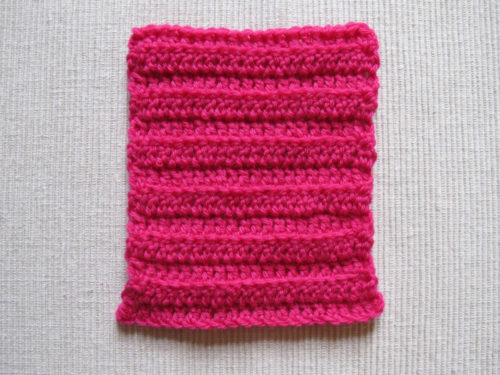In the March tutorial, I explained how to insert your hook in default mode i. e., when the pattern doesn’t indicate anything in particular.
Now we are entering “custom mode”, to see the different effects we can get by inserting our hook in other ways in the stitch in the row below.
Let’s do it stitch by stitch, and let’s start with the US double crochet!
In the previous tutorial, I showed you how to identify the two loops of the stitch by pivoting the work towards you to look at the top of the row.

Loop 1 is the front loop and loop 2 is the back loop.
This is based on the position of these loops as seen from the crocheter’s perspective. The front loop is the loop closer to you and the back loop is the loop farther from you.
We are going to look at what happens when we insert our hook through one loop only instead of both. Let’s start with the front loop!

The hook goes under the first loop and exits between the loops, in the middle of the top of the stitch.
This is a swatch worked in dc flo, double crochet in the front loop only:

Compared to the fabric we get when we work through both loops, this is lighter and has more drape. The (rather subtle) horizontal ridges are the back loops of the stitches worked through the front loop only on the other side of the fabric.
I find that working under the front loop only underlines the elegance of the double crochet. It’s an easy way to produce a sophisticated fabric.
Let’s have a look at the back loop.

The hook is inserted between the loops and under the second one. It exits the fabric at the back of the work.
This may seem like a subtle change, but it produces a very different fabric:

This swatch is very textured, and looks and feels thicker than the previous one. The fabric is quite elastic.
I find this texture very interesting. To use it well, I think it’s necessary to manage the elasticity of the fabric, perhaps using a smaller hook. It produces a ribbed fabric, but in my opinion, there is not enough bounce in this stitch pattern to make functional ribbing.
Working through the front loop or the back loop only is a well-known way to vary a solid dc fabric, and you will find stitch patterns based on these techniques in many books and patterns.
I also wanted to try another way to insert my hook in a dc, one that is much more unusual.

This is our swatch as it presents itself when we have just turned and are going to start a new row. The dot shows the exact spot where the hook is inserted in “default mode”, under both loops of the top of the stitch. I wanted to explore the little loop indicated by the arrow, the single loop that closes the bottom of the space where you normally insert your hook.
Since this loop isn’t commonly used, I don’t know that it has a name. I call it the “bonus loop”.
Here is how to insert your hook through the bonus loop:

The hook goes through the loop from bottom to top and exits in front of the top of the stitch.
Here’s what we get:

Working in the bonus loop makes the top of the stitch tilt towards the back of the work. The fabric shows very clear horizontal ridges, similar to a chain on the surface of the fabric.
In the swatch, I worked through the bonus loop on every row, which makes the fabric reversible. This also makes the rows much shorter, so you need more rows to reach a specific height. You could also work through the bonus loop only on wrong side rows, and get the texture only on the right side.
This inspires me to play around with this stitch. I actually used my swatch to explore different ways of handling the selvedges for this stitch pattern – that’s why my swatch looks a bit wonky.
There are other ways of creating this type of texture, with the stitch tops exposed on the surface of the fabric. One of these is using post stitches, working around the body of the stitch. However, post stitches will yield a much firmer fabric than working through the bonus loop. A softer fabric with more drape opens up new possibilities.
If you prefer moving images, here is a video that sums up what I’ve shown here:
I hope this motivates you to explore working through the different loops, both the usual ones and the bonus one. Feel free to share your suggestions or experiences in the comments below.
Take care, and see you soon!


I thought this was very informative. I shared it with friends on Facebook. If this is a problem, I will remove. Thank you for all your tutorials.
I’m very happy that you found it useful, and I hope your friends will, too!